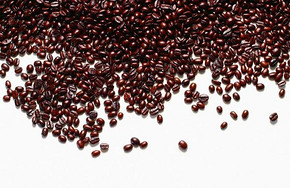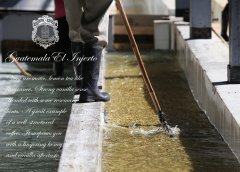Guatemala coffee beans have superior geographical location and taste characteristics.
Follow the caf é (Wechat official account vdailycom) and found that Beautiful Cafe opened a small shop of its own.
Tiny Nanguo Highland
The Vivette Nanguo Highlands have warm, humid Caribbean air from the Central Mountains, clouds and a changeable climate; the land is a volcanic area, cultivating fertile volcanic soil. Coupled with the fact that it is located on the edge of plate activity, the severe alpine basin topography has given birth to a rich and lively coffee style under such changeable wind and soil conditions. as a result, the high-quality Vivette South fruit coffee beans are divided into seven grades according to the elevation, and the higher the quality is at the high altitude, the more mellow it is.
Of the three major non-volcanic coffee-producing regions in Guatemala, the Weitango Highlands has the driest climate and the highest elevation. The dry and hot wind from Mexico's Tehuantepec plateau protects the coffee from frost and can be grown to 2000 meters (6500 feet).
Evaluation results of representatives of producing areas
Grade: SHB
Producing area: Vivette Nanguo
Baking degree: medium depth baking
Treatment: washing
Variety: Kaddura, Kaduai, bourbon
Soil: volcanic soil
Flavor: nuts, dark chocolate, cut tobacco
Features: balanced and pleasant taste, high mellow thickness and wine aftertaste
Because of its remote location, all coffee farmers have to process their own coffee. Fortunately, there are so many streams in the area that small processing plants can be set up almost anywhere.

Superior geographical location
Guatemala is located in Guatemala in Central America, bordering the Pacific Ocean to the west, the Caribbean Sea to the east, Mexico to the north, Belize to the northeast, Honduras and El Salvador to the southeast. The name Guatemala comes from the Mayan language, meaning "thelandofmanytrees". It is located in Central America and is known as the "Pearl in the Crown of China and the United States". It is a major coffee producer in Central America and ranks eighth in the world in annual coffee production.
Although the land area is limited, it has a rich and diverse climate, and there are many volcanoes. The coffee produced under the volcanic soil is a rich boutique coffee. The average altitude in Guatemala is very high, which means that the temperature difference between day and night is relatively large in the environment where coffee trees grow. This harsh environment makes coffee fruits grow longer and slower on coffee trees, and beans are hard beans, but the flavor is more complete and richer.
Volcanic soil, precipitation, temperature, humidity, altitude. These unique factors make Guatemala have a natural environment suitable for coffee growth.
Guatemalan coffee beans, produced in Guatemala, belong to bourbon coffee beans and are one of the more sour varieties. It has a strong sour taste, mellow taste and slightly wild taste, and can be used as a single drink or for the preparation of comprehensive coffee.
Characteristics of coffee beans
Taste: bitter and fragrant, good taste.
Guatemalan coffee once enjoyed the reputation of the best quality coffee in the world. Extremely hard beans are famous for their elegant, sour, clean and well-structured coffee, as well as sour apple, berry, jasmine, orange peel, green pepper, sweet and sour fruit, sweet chocolate, and even smoky aftertaste. Coffee beans are full-grained, delicious and balanced, and the coffee is mellow and sour. The coffee prepared with it is pure, full-bodied and well received, and it is the best material for mixed coffee.
Such a rich regional flavor should be related to the soil and water in the eight major producing areas of the dangerous country. Among them, the five producing areas of Antigua, Ekat Nango Valley, Attilan, St. Mark and Huaiqiang belong to volcanic geology. In addition, Vivetta Nanguo, Koban and New Oriental producing areas belong to the climate of non-volcanic highlands or tropical rain forests. Guatemala is home to more than 300 microclimates, making it the largest in the world.
Important Notice :
前街咖啡 FrontStreet Coffee has moved to new addredd:
FrontStreet Coffee Address: 315,Donghua East Road,GuangZhou
Tel:020 38364473
- Prev

Guatemalan coffee: a combination of nutty, cocoa and soft spices
Following Cafe Review (Wechat official account vdailycom) found that Beautiful Caf é opened a small shop of its own a cup of Guatemalan Antigua coffee, seems to let us see the sudden disappearance of the mysterious Mayans thriving on the ancient land, history brushed their existence, history made their forever. The fertile volcanic soil of Guatemala breeds boutique coffee with unique flavor.
- Next

2017 Incht Manor in Guatemala bid for lots of "Ruby Geisha" EI06-01
2017 EI06-01 Ruby Geisha Farm name: El Injerto Manor Certification: rainforest Alliance Coffee name: EI06-01 Harvest date: January-March 2017 Variety: MALAWI GESHA History: this exotic luxury seed comes directly from Malawi, which is more than the traditional Gesha.
Related
- Detailed explanation of Jadeite planting Land in Panamanian Jadeite Manor introduction to the grading system of Jadeite competitive bidding, Red bid, Green bid and Rose Summer
- Story of Coffee planting in Brenka region of Costa Rica Stonehenge Manor anaerobic heavy honey treatment of flavor mouth
- What's on the barrel of Blue Mountain Coffee beans?
- Can American coffee also pull flowers? How to use hot American style to pull out a good-looking pattern?
- Can you make a cold extract with coffee beans? What is the right proportion for cold-extracted coffee formula?
- Indonesian PWN Gold Mandrine Coffee Origin Features Flavor How to Chong? Mandolin coffee is American.
- A brief introduction to the flavor characteristics of Brazilian yellow bourbon coffee beans
- What is the effect of different water quality on the flavor of cold-extracted coffee? What kind of water is best for brewing coffee?
- Why do you think of Rose Summer whenever you mention Panamanian coffee?
- Introduction to the characteristics of authentic blue mountain coffee bean producing areas? What is the CIB Coffee Authority in Jamaica?

